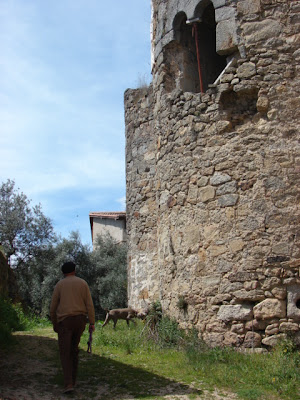 |
| Miranda del Castañar, many houses painted with geometric designs |
 |
| Gredos |
After the reconquest the area was heavily re-populated with French families hence the many names in the area including "Francia".
San Martin del Castañar is a compact village with a stream running through it and a some castle walls now guarding the cemetery. The church of San Martin is from XIII century and has the most beautiful Mozarabe ceiling made of intricate wood carvings in geometric designs. The plaza del toros is very ancient and was originally the plaza de armas, the assembling area for the army guarding the castle. There is an unusual shop in the main plaza, you can just about see it below, a man carefully cultivates bonsai chestnut, oak and beech trees.
Mogarraz is one of the more remote villages, not as visited, a rather creepy atmosphere of dilapidation, very haunting.
 |
| Something missing," bonum vinum laetificat cor hominis" Yes, definitely! |
Miranda del Castañar is in a beautiful situation on a ridge surrounded by woodland and approached through cherry orchards. The roofs make an intricate interlocking pattern of tiles. It was an important templar stronghold and there are may Maltese crosses on the buildings. It is contained within the original walls which are double in some places with secret alley ways in between. We visited an amazing old bodega now a shop, Tienda Museo Bodega La Muralla.
Some of the original huge wine barrels were still in place from when it was first established in 1755. It is under the street level at the entrance, the wine was piped through the walls and sold through a tap on the other side which was on a different level, apparently it was still functioning until 1940.
Unfortunately we were unable to visit the famed monastery of Peña de Francia as a deep mist had descended so it seemed pointless to accend to 1500 m, very chilly and no view. Next time.
We departed on the incredibly tortuous road from La Alberca that winds its way down the mountain in sharp hairpin bends, down to the gorgeous Batueca valley, a paradise of running water and dense green woodlands. It is still very remote but one can imagine how completely other- worldly it must have been before the road access. It was here that the order of Carmelitas Descalzos de Castilla built their monastery in 1599. It is known as Santo Desierto de San José de las Batuecas http://monasteriodelasbatuecas.wordpress.com/el_monasterio/
The view of the monastery is stunning as one approaches down the valley, I was so looking forward to a good look around but it was not to be. The padres certainly didn't want to see me, all very well barred and bolted with a very unwelcoming sign..........how can they say there is nothing of interest to see, how arrogant and dismissive, really cross.
They live such privileged lives, so few of them living in a gorgeous country estate supported heavily by the state, there should be at least a few open days every now and then if only to remind them of the real world and how little their "contemplative order" has any effect on the lives of us who have to live outside their ivory tower grrrrrrrr!
We wanted to come back to the finca through Las Hurdes and stopped off to look down upon the so called Meandros del Alagón, a spectacular part of the river Alagón, even more dramatic now as the water has receded due to the drought exposing another layer to the meander.





















No comments:
Post a Comment
Follow the latest news from Finca al-manzil- What to do and see in Extremadura and Beyond.............